Mycosis of the feet is one of the most common diseases caused by parasitic fungi. There are several types of this pathology in medical practice. It is important to identify the fungus on the foot at the very beginning of its development. Then it will be quicker and easier to get rid of it. In this case, you do not need special treatment, and most importantly, surgical intervention. With weak manifestations of fungal activity, it is enough to use antifungal ointments or baths according to folk recipes.
Mushroom and its varieties
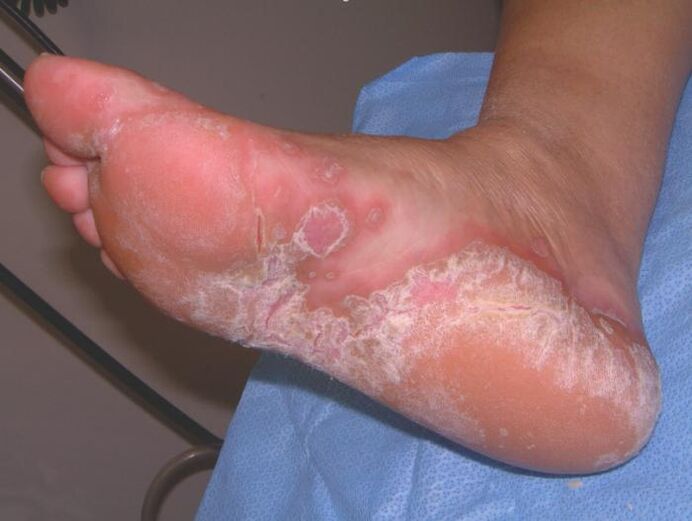
Despite the prevalence of athlete's foot, not everyone who is infected knows what an athlete's foot looks like.
The following are the main types of mycoses:
- Squamous cell carcinoma or scaly.
- Intertriginous. It is characterized by the type of intertrigo of the skin.
- Hypertrophic, atrophic and normotrophic onychomycosis. The difficulty in treating these diseases is that all varieties can be combined with one another.
- Dyshidrotic. It is characterized by a violation of the work of the sweat glands.
At different stages of development, this pathology looks different. Mycosis of the feet is the common name for two diseases: epidermophytosis and rubromycosis, the process of which occurs in the same way.
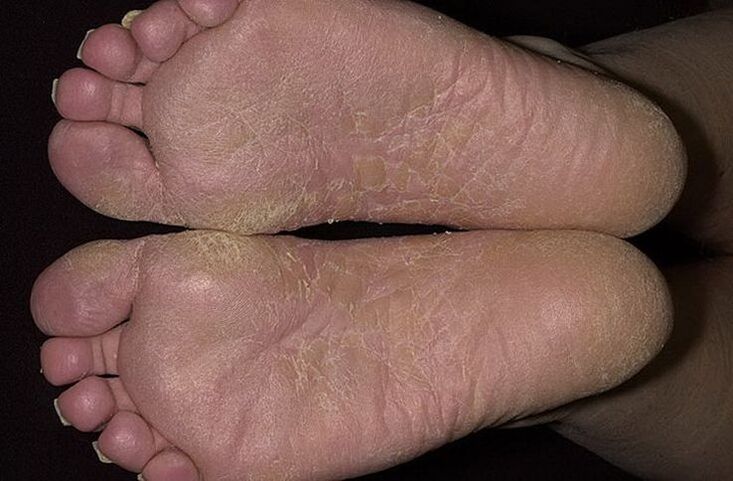
Scaly mycoses
At the initial stage, the fungus manifests itself by the defeat of one foot, and after a certain time the disease passes to the other.
The skin turns red and then flakes off. The area of redness is different in all patients and depends on the stage of development. Many people are not even bothered by itching in the affected area, the skin cannot peel off. That is why they do not turn to a dermatologist until the legs are affected by the last stage of the disease.
Dyshidrotic fungal infection
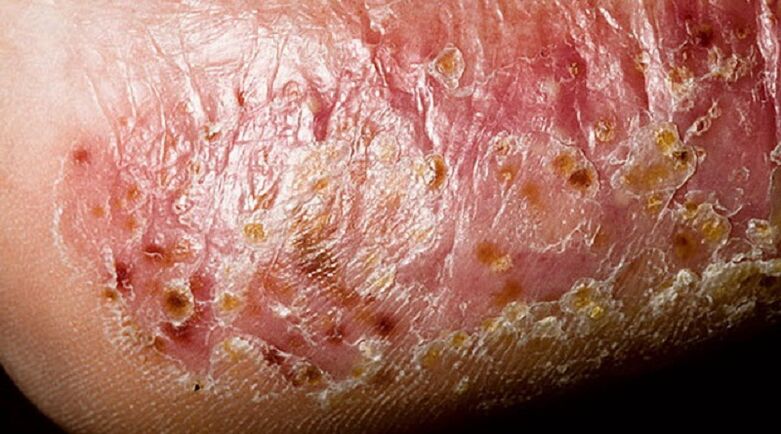
Anyone who suspects the occurrence of this disease should know what athlete's foot of any shape looks like. This pathology is characterized by the appearance of miniature vesicles on the arch of the foot. Very little time passes, and they combine and transform into large bubbles, the shell of which will soon break and the superficial lesion of the skin will become visually noticeable.
The pathology can spread throughout the leg, with areas of diaper rash appearing. In this case, the patient begins to itch, painful sensations appear. After everything has healed, the peeling begins.
The most unpleasant disease is the formation of a bacterial fungus. A cloudy liquid and pus flow out of the bursting bubbles. At this stage of the development of the pathology, there is a slight increase in temperature and excruciating pain. The skin of the feet is swollen.
The process of the dyshidrotic form of mycosis can take several months. Phases of improvement in the condition of the feet alternate with relapses.
Intertriginous fungus
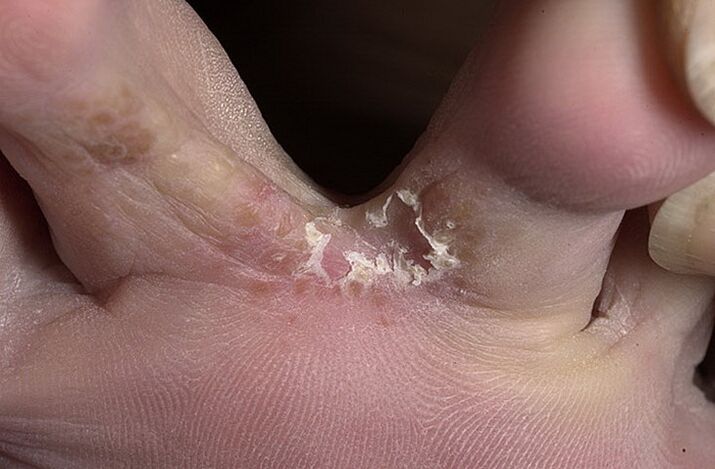
This type of fungus on the skin of the feet is the most common. It occurs independently or in conjunction with squamous cell pathology. The disease is manifested by cracks in the skin that have a white border around them, and then the skin begins to peel off. The space between your fingers will get wet. The patient feels itching and burning. Surface defects of the skin appear, accompanied by severe pain.
The protective functions of the skin are reduced and it loosens. This will encourage the strep infection to penetrate the skin. Purulent inflammation occurs, which is characterized by redness, itching, swelling and severe pain.
The intertriginous fungus is most often characterized by a long, chronic course of the disease. The pain usually subsides in winter and worsens again in summer.
Onychomycosis, or nail fungus

When the first signs of the disease appear, the patient's task is to timely contact a dermatologist and determine how to remove the fungus on the legs.
Onychomycosis of the nails is a more dangerous disease than a fungal infection of the feet because it takes much longer to heal.
Types of fungal infections that affect the nail plate:
- Atrophic onychomycosis. First the nail thins, then it collapses.
- Hypertrophic onychomycosis. The thickness of the nail increases and turns yellow. Length growth stops. The nail plate begins to crumble and peel off.
- Mold onychomycosis. This pathology does not develop on its own. It usually progresses against the background of other diseases. In this case, the nail plate can be painted in any color, from black to green. The periungual roll is often inflamed.
In its neglected form, the disease affects the entire body and even invades the internal organs. Pathological changes often begin to develop on the edge of the nail plate. Stripes, spots, and other "patterns" appear first.
Treatment methods
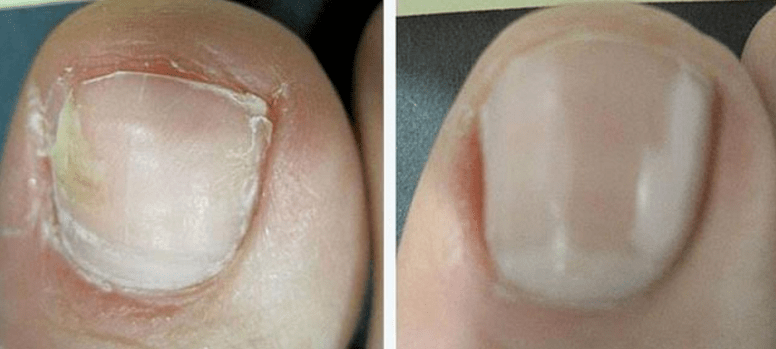
Not every patient knows how to remove fungus from their feet, but dermatologists do. Treatment is primarily to block a fungal infection from developing. To prevent re-infection of the feet with a fungus, complex treatment is used:
- External therapy course. In the treatment, antifungal ointments, creams and sprays are used.
- The course of treatment with the use of antifungal drugs.
- Use of antihistamines. They are taken in case of severe itching and hypersensitivity to irritants that cause allergies.
- The course of therapy with the intake of vitamins and minerals.
- Antibacterial drugs. They are used in case of bacterial infection of the body.
During a visit to the doctor, a person will find out how to treat nail fungus, heels, and the space between the fingers. With an advanced form of the disease, the doctor usually prescribes complex treatment with taking tablets and ointments. Systemic drugs are prescribed to patients who have already begun a severe course of the process.
To treat a fungal infection on the legs at home, the following folk recipes are used:
- Vinegar. Wine vinegar is used in baths because of its antiseptic properties.
- Salt and soda. They are dissolved in water in equal amounts and form baths that will help remove fungus on the feet.
- Oak bark, marigold inflorescences, blackberries. Wash the affected areas of the feet with a decoction of these medicinal herbs.
The most effective is the complex treatment of the fungus with ointments and drugs of various pharmacological effects. Treatment is never necessary if you listen to doctors' recommendations and take preventive measures on a regular basis.
Antifungal drugs
The fungus of the feet and the interdigital space is removed with effective fungicides.
Since the fungus can manifest itself in any form, it is necessary for a specialist to choose an effective means of combating this infection. Some drugs are toxic and can cause side effects; they are taken under the strict supervision of a doctor. A quick positive result of treatment depends on the correct diagnosis not only of the disease, but also of the stage of its development.

















